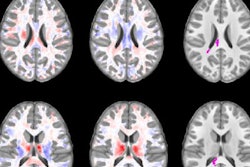
MR images show that the brains of athletes who have experienced a recent concussion continue to undergo subtle changes in structure and activity -- even after the athletes have been cleared to return to action, according to research published online August 24 in Scientific Reports.
Toronto-based researchers found MRI-based measures of depressed brain function and, in some cases, markers of edema to indicate swelling and inflammation. Both conditions would suggest the brain is lagging behind in terms of recovery after other concussion symptoms have resolved (Sci Rep, August 24, 2017).
 Nathan Churchill, PhD, from St. Michael's Hospital.
Nathan Churchill, PhD, from St. Michael's Hospital."What is unique about this study is that we examined the brains of these athletes at the time of medical clearance, right when these symptoms dissipated, and they were free to return to full normal athletic activities," said Nathan Churchill, PhD, from the Neuroscience Research Program at St. Michael's Hospital. "It raises the question: When, exactly, does recovery happen? And does that map onto what we are seeing clinically?"
Concussion conundrum
While the health benefits of athletic activity and exercise in general outweigh the risk of concussion, the issue of repeated head trauma, however subtle, has caused concern in all contact sports. Diffusion-tensor MRI (DTI-MRI) scans, for example, have shown significant brain changes in young football players after just one season, as well as how heading a soccer ball more often is likely to cause concussion symptoms.
With appropriate rest and/or treatment, injured athletes eventually are given the medical OK to return to the field or court. But what's the best time to return to activity, and what are the consequences if it's too early?
Churchill and colleagues began to answer those questions in a 2016 study through MRI scans of college athletes with a history of concussion. They found changes in brain size, blood flow, and structural white matter months and even years after injury.
Indeed, the literature indicates that people who have had concussions -- particularly in sports -- and who return to play too early are at increased risk of negative outcomes, such as a second concussion or possibly worse symptoms, Churchill told AuntMinnie.com.
"To us, that suggested there is some ongoing process -- be it recovery or reorganization in the brain -- that goes on for quite some time after the initial injury," he said.
To explore the potential lingering effects of concussion, Churchill's group recruited 27 concussed athletes (mean age, 20.1 years ± 2.0) for the study, along with 27 age- and gender-matched control athletes (mean age, 20.0 years ± 1.8). The athletes included volleyball, hockey, soccer, football, rugby, basketball, and lacrosse players. The subjects were imaged at St. Michael's Hospital on a 3-tesla MR scanner (Magnetom Skyra, Siemens Healthineers) with a 20-channel head receiver coil.
Concussed athletes were scanned on two occasions. The first exam took place within one to seven days of the injury (median, four days). The subjects were scanned again after they received medical clearance to return to action (median, seven days after clearance). On average, the athletes were playing again in 18 days. Based on structural MRI, no abnormalities, such as clinically significant white-matter hyperintensities, contusions, or microhemorrhages, were identified among the concussed athletes.
(Two concussed athletes did not undergo a second MRI scan because they dropped out of school. Another injured athlete was scanned upon return to play but did not have acute imaging. Therefore, a total of 24 athletes completed both the acute MRI and follow-up scans.)
MRI protocols
The protocol included DTI-MRI to detect changes in the microstructure of brain tissue, based on fractional anisotropy to measure the directionality of water diffusion and mean diffusivity to quantify total water diffusion in the brain's white matter. Decreased fractional anisotropy values and elevated mean diffusivity are potential indications of an abnormality.
In addition, functional MRI (fMRI) was used to assess brain function based on regional blood oxygenation levels. Through resting-state fMRI, the researchers sought to assess global functional connectivity across the brain.
"This [fMRI] gives us more of a window into potential cognitive outcomes," Churchill explained. "These are resting state measures, so we did not have subjects doing active tasks, but we do see evidence of changes in how brain regions communicate with each other."
Interestingly, the researchers found widespread adverse effects in white-matter tracts, which included clusters located predominantly within the right corona radiata and bilaterally in posterior limbs of the internal capsule.
"We saw that at acute injury these brain regions show evidence of being hyperconnected -- areas that are involved in vision, planning certain tasks, and motor activities," Churchill said. "What is quite striking is that this dovetails with studies done on stroke and more severe brain injury where this hyperconnection is seen as a possible protective mechanism whereby the brain is increasing redundancy communication, so if there is a further injury, it is less likely to be devastating."
Telltale numbers
DTI analyses showed concussed athletes' average fractional anisotropy was significantly less than the control subjects' value (mean difference, -0.0156 ± 0.003; p < 0.001) for the scan right after the injury. Fractional anisotropy was also less for the concussed athletes at the second MRI scan (mean difference, -0.0167 ± 0.0031; p < 0.001).
Similar results were obtained for mean diffusivity. Concussed athletes exhibited statistically significant increases in average mean diffusivity at both the first MRI scan (mean difference, (1.84 ± 0.66) x 10-5 mm/sec; p = 0.004) and upon clearance to play (mean difference, (1.67 ± 0.52) x 10-5 mm/sec; p < 0.001).
"Based on what we know from previous literature on mild traumatic brain injury, we interpreted these [findings] as likely signs of cellular swelling and potential inflammatory processes," Churchill told AuntMinnie.com. "We don't have an exact understanding of the mechanism just yet, but it is consistent with what has been put forth before for these kinds of conditions."
As for the fMRI results, the average global function connectivity value for concussed athletes was significantly greater than for the controls (mean difference, 0.0310 ± 0.0120; p = 0.03), and it was also higher at the time of medical clearance to return to play (mean difference, 0.0325 ± 0.0073; p < 0.001). Given that the difference between the first and second MRI scans was not statistically significant (mean change, 0.002 ± 0.008; p = 0.92), the researchers concluded that adverse changes in the brain were still present at the latter time point.
"What was quite interesting to us was whatever this marker may be, this microstructural change that we are seeing early in the injury -- an average of three days postconcussion -- was still present at the time of medical clearance," Churchill said. "We did not necessarily expect to see that this process would persist for so long."
 MR images show mean fractional anisotropy in white matter (above) and mean global functional connectivity in gray matter (below) for control subjects compared with concussed athletes after their injury (acute) and when they were clinically cleared to return to play (RTP). Red circles indicate areas of significant concussion effects. Images courtesy of Nathan Churchill, PhD.
MR images show mean fractional anisotropy in white matter (above) and mean global functional connectivity in gray matter (below) for control subjects compared with concussed athletes after their injury (acute) and when they were clinically cleared to return to play (RTP). Red circles indicate areas of significant concussion effects. Images courtesy of Nathan Churchill, PhD.Clinical relevance
Churchill said the clinical relevance of the findings is not quite clear yet.
"At the risk of being a bit disappointing, I would say that the clinical relevance at this exact moment is somewhat nil," he said. "All of these athletes went through very comprehensive assessment programs; they were tested at baseline cognitively and symptomatically in terms of motor and visual function. When they were medically cleared by all measures, they were back to their normal level of performance. So we can't show that these people have some sort of lingering impairment that we have to worry about."
That is not to say the findings are not without merit. Clinicians should evaluate previously injured areas of the brain that might become vulnerable if the athletes experience another concussion or repeated head injuries.
"For example, if we were to have someone get a second concussion, we might want to look at their ability to switch between tasks, their ability to maintain visual tracking, and those sorts of things," Churchill said. "It is a window into possible areas of risk."
The researchers plan to follow these athletes in the coming months and years to see if their brain structure and executive function return to baseline levels or if their condition is "their new normal, whatever that might be," he said.


.fFmgij6Hin.png?auto=compress%2Cformat&fit=crop&h=100&q=70&w=100)





.fFmgij6Hin.png?auto=compress%2Cformat&fit=crop&h=167&q=70&w=250)











